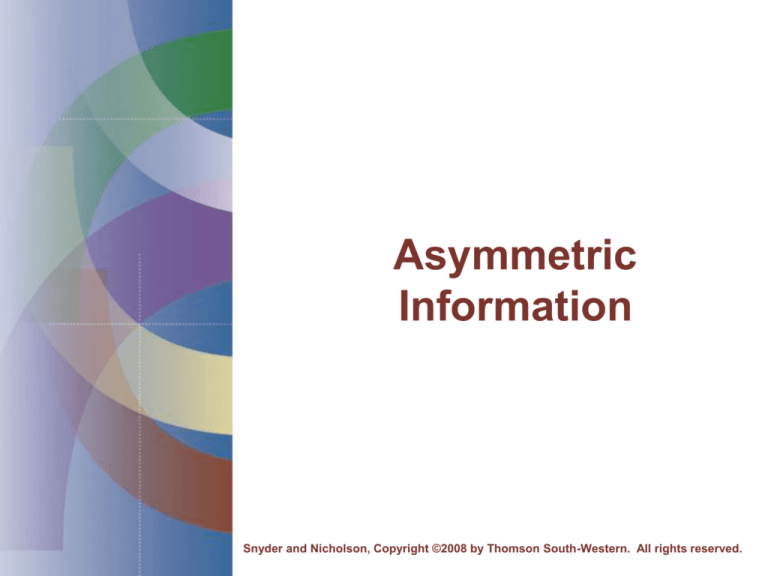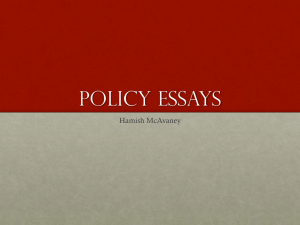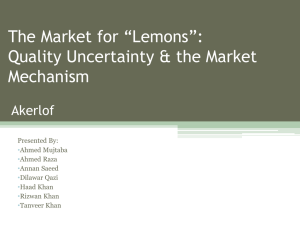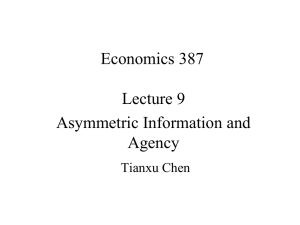
Asymmetric
Information
Snyder and Nicholson, Copyright ©2008 by Thomson South-Western. All rights reserved.
Asymmetric Information
• Transactions can involve a considerable
amount of uncertainty
– can lead to inefficiency when one side has
better information
• The side with better information is said
to have private information or
asymmetric information
The Value of Contracts
• Contractual provisions can be added in
order to circumvent some of the
inefficiencies associated with
asymmetric information
– rarely do they eliminate them
Principal-Agent Model
• The party who proposes the contract is
called the principal
• The party who decides whether or not to
accept the contract and then performs
under the terms of the contract is the
agent
– typically the party with asymmetric
information
Leading Models
• Two models of asymmetric information
– the agent’s actions affect the principal, but
the principal does not observe the actions
directly
• called a hidden-action model or a moral hazard
model
– the agent has private information before
signing the contract (his type)
• called a hidden-type model or an adverse
selection model
First, Second, and Third Best
• In a full-information environment, the
principal could propose a contract that
maximizes joint surplus
– could capture all of the surplus for himself,
leaving the agent just enough to make him
indifferent between agreeing to the
contract or not
• This is called a first-best contract
First, Second, and Third Best
• The contract that maximizes the
principal’s surplus subject to the
constraint that he is less well informed
than the agent is called a second-best
contract
• Adding further constraints leads to the
third best, fourth best, etc.
Hidden Actions
• The principal would like the agent to
take an action that maximizes their joint
surplus
• But, the agent’s actions may be
unobservable to the principal
– the agent will prefer to shirk
• Contracts can mitigate shirking by tying
compensation to observable outcomes
Hidden Actions
• Often, the principal is more concerned
with outcomes than actions anyway
– may as well condition the contract on
outcomes
Hidden Actions
• The problem is that the outcome may
depend in part on random factors
outside of the agent’s control
– tying the agent’s compensation to
outcomes exposes the agent to risk
– if the agent is risk averse, he may require
the payment of a risk premium before he
will accept the contract
Owner-Manager Relationship
• Suppose a firm has one representative
owner and one manager
– the owner offers a contract to the manager
– the manager decides whether to accept the
contract and what action e 0 to take
• an increase in e increases the firm’s gross
profit but is personally costly to the manager
Owner-Manager Relationship
• The firm’s gross profit is
g = e +
– where represents demand, cost, and
other economic factors outside of the
agent’s control
• assume ~ (0,2)
– c(e) is the manager’s personal disutility
from effort
• assume c’(e) > 0 and c’’(e) < 0
Owner-Manager Relationship
• If s is the manager’s salary, the firm’s
net profit is
n = n – s
• The risk-neutral owner wishes to
maximize the expected value of profit
E(n) = E(e + – s) = e – E(s)
Owner-Manager Relationship
• We will assume the manager is risk
averse with a constant risk aversion
parameter of A > 0
• The manager’s expected utility will be
E u E s
A
2
Var s c e
First-Best
• With full information, it is relatively easy
to design an optimal salary contract
– the owner can pay the manager a salary if
he exerts a first-best level of effort and
nothing otherwise
– for the manager to accept the contract
E(u) = s* - c(e*) 0
First-Best
• The owner will pay the lowest salary
possible [s* = c(e*)]
• The owner’s net profit will be
E(n) = e* - E(s*) = e* - c(e*)
– at the optimum, the marginal cost of effort
equals the marginal benefit
Second Best
• If the owner cannot observe effort, the
contract cannot be conditioned on e
– the owner may still induce effort if some of
the manager’s salary depends on gross
profit
– suppose the owner offers a salary such as
s(g) = a + bg
– a is the fixed salary and b is the power of
the incentive scheme
Second Best
• This relationship can be viewed as a
three-stage game
– owner sets the salary (choosing a and b)
– the manager decides whether or not to
accept the contract
– the manager decides how much effort to
put forth (conditional on accepting the
contract)
Second Best
• Because the owner cannot observe e
directly and the manager is risk-averse,
the second-best effort will be less than
the first-best effort
– the risk premium adds to the owner’s cost
of inducing effort
First- versus Second-Best Effort
The owner’s MC is higher in the second best, leading to
lower effort by the manager
MC in second best
c’(e) + risk term
MC in first best
c’(e)
1
MB
e
e**
e*
Moral Hazard in Insurance
• If a person is fully insured, he will have
a reduced incentive to undertake
precautions
– may increase the likelihood of a loss
occurring
Moral Hazard in Insurance
• The effect of insurance coverage on an
individual’s precautions, which may
change the likelihood or size of losses,
is known as moral hazard
Mathematical Model
• Suppose a risk-averse individual faces
the possibility of a loss (l) that will
reduce his initial wealth (W0)
– the probability of loss is
– an individual can reduce this probability by
spending more on preventive measures (e)
Mathematical Model
• An insurance company offers a contract
involving a payment of x to the
individual if a loss occurs
– the premium is p
• If the individual takes the coverage, his
expected utility is
E[u(W)] = (1-)u(W0-e-p) + ()u(W0-e-p-l+x)
First-Best Insurance Contract
• In the first-best case, the insurance
company can perfectly monitor e
– should set the terms to maximize its expected
profit subject to the participation constraint
• the expected utility with insurance must be at least
as large as the utility without the insurance
– will result in full insurance with x = l
– the individual will choose the socially efficient
level of precaution
Second-Best Insurance Contract
• Assume the insurance company cannot
monitor e at all
– an incentive compatibility constraint must be
added
• The second-best contract will typically not
involve full insurance
– exposing the individual to some risk induces
him to take some precaution
Hidden Types
• In the hidden-type model, the individual
has private information about an innate
characteristic he cannot choose
– the agent’s private information at the time
of signing the contract puts him in a better
position
Hidden Types
• The principal will try to extract as much
surplus as possible from agents through
clever contract design
– include options targeted to every agent
type
Nonlinear Pricing
• Consider a monopolist who sells to a
consumer with private information about
his own valuation for the good
• The monopolist offers a nonlinear price
schedule
– menu of different-sized bundles at different
prices
– larger bundles sell for lower per-unit price
Mathematical Model
• Suppose a single consumer obtains surplus
from consuming a bundle of q units for
which he pays a total tariff of T
u = v(q) – T
– assume that v’(q) > 0 and v’’(q) < 0
– the consumer’s type is
• H is the “high” type (with probability of )
• L is the “low” type (with probability of 1-)
• 0 < L < H
Mathematical Model
• Suppose the monopolist has a constant
average and marginal cost of c
• The monopolist’s profit from selling q units
is
= T – cq
First-Best Nonlinear Pricing
• In the first-best case, the monopolist
observes
• At the optimum
v’(q) = c
– the marginal social benefit of increased
quantity is equal to the marginal social cost
First-Best Nonlinear Pricing
This graph shows the consumers’ indifference curves
(by type) and the firm’s isoprofit curves
T
U0H
U0L
q
First-Best Nonlinear Pricing
A is the first-best contract offered to the “high” type and B
is the first-best offer to the “low” type
T
A
U0H
U0L
B
q
Second-Best Nonlinear Pricing
• Suppose the monopolist cannot observe
– knows the distribution
• Choosing A is no longer incentive
compatible for the high type
– the monopolist must reduce the high-type’s
tariff
Second-Best Nonlinear Pricing
The “high” type can reach a higher indifference curve by
choosing B
T
A
U0H
U2H
C
U0L
B
q
To keep him from
choosing B, the
monopolist must
reduce the “high”
type’s tariff by offering
a point like C
Second-Best Nonlinear Pricing
The monopolist can also alter the “low” type’s bundle to
make it less attractive to the high type
T
A
E
C
U0H
U2H
U0L
B
D
q**L
q**H
q
Monopoly Coffee Shop
• The college has a single coffee shop
– faces a marginal cost of 5 cents per ounce
• The representative customer faces an
equal probability of being one of two
types
– a coffee hound (H = 20)
– a regular Joe (L = 15)
• Assume v(q) = 2q0.5
First Best
• Substituting such that marginal cost =
marginal benefit, we get
q = (/c)2
q*L = 9
q*H = 16
T*L = 90
T*H = 160
E() = 62.5
Incentive Compatibility when Types Are Hidden
• The first-best pricing scheme is not
incentive compatible if the monopolist
cannot observe type
– keeping the cup sizes the same, the price
for the large cup would have to be reduced
by 30 cents
– the shop’s expected profit falls to 47.5
Second Best
• The shop can do better by reducing the
size of the small cup
• The size that is second best would be
LqL-0.5 = c + (H - L)qL-0.5
q**L = 4
T**L = 60
E() = 50
Adverse Selection in Insurance
• Adverse selection is a problem facing
insurers where the risky types are more
likely to accept an insurance policy and
are more expensive to serve
– assume policy holders may be one of two
types
• H = high risk
• L = low risk
First Best
• The insurer can observe the individual’s
risk type
• First best involves full insurance
– different premiums are charged to each
type to extract all surplus
First Best
W2
U0L
certainty line
U0H
Without insurance
each type finds
himself at E
B
A and B represent
full insurance
A
E
W1
Second Best
• If the insurer cannot observe type, firstbest contracts will not be incentive
compatible
– if the insurer offered A and B, the high-risk
type would choose B
– the insurer must change the coverage
offered to low-risk individuals to make it
unattractive to high-risk individuals
First Best
W2
U1H
U0L
certainty line
U0H
B
The high-risk type
is fully insured, but
his premium is
higher (than it
would be at B)
C
D
A
E
The low-risk type
is only partially
insured
W1
Market Signaling
• If the informed player moves first, he
can “signal” his type to the other party
– the low-risk individual would benefit from
providing his type to insurers
• he should be willing to pay the difference
between his equilibrium and his first-best
surplus to issue such a signal
Market for Lemons
• Sellers of used cars have more
information on the condition of the car
– but the act of offering the car for sale can
serve as a signal of car quality
• it must be below some threshold that would
have induced the owner to keep it
Market for Lemons
• Suppose there is a continuum of
qualities from low-quality lemons to
high-quality gems
– only the owner knows a car’s type
• Because buyers cannot determine the
quality, all used cars sell for the same
price
– function of average car quality
Market for Lemons
• A car’s owner will choose to keep a car
that is in the upper end of the spectrum
– reduces the average quality
– reduces the market price
– leads sellers of the high end of the
remaining cars to keep their cars
• reduces average quality and market price
Adverse Selection
• Consider a used car market.
• Two types of cars; “lemons” and
“peaches”.
• Each lemon seller will accept $1,000; a
buyer will pay at most $1,200.
• Each peach seller will accept $2,000; a
buyer will pay at most $2,400.
Adverse Selection
• If every buyer can tell a peach from a
lemon, then lemons sell for between
$1,000 and $1,200, and peaches sell for
between $2,000 and $2,400.
• Gains-to-trade are generated when
buyers are well informed.
Adverse Selection
• Suppose no buyer can tell a peach from
a lemon before buying.
• What is the most a buyer will pay for
any car?
Adverse Selection
• Let q be the fraction of peaches.
• 1 - q is the fraction of lemons.
• Expected value to a buyer of any car is
at most
EV $1200(1 q) $2400q.
Adverse Selection
• Suppose EV > $2000.
• Every seller can negotiate a price
between $2000 and $EV (no matter if
the car is a lemon or a peach).
• All sellers gain from being in the market.
Adverse Selection
• Suppose EV < $2000.
• A peach seller cannot negotiate a price
above $2000 and will exit the market.
• So all buyers know that remaining
sellers own lemons only.
• Buyers will pay at most $1200 and only
lemons are sold.
Adverse Selection
• Hence “too many” lemons “crowd out”
the peaches from the market.
• Gains-to-trade are reduced since no
peaches are traded.
• The presence of the lemons inflicts an
external cost on buyers and peach
owners.
Adverse Selection
• How many lemons can be in the market
without crowding out the peaches?
• Buyers will pay $2000 for a car only if
EV $1200(1 q ) $2400q $2000
Adverse Selection
• How many lemons can be in the market
without crowding out the peaches?
• Buyers will pay $2000 for a car only if
EV $1200(1 q ) $2400q $2000
2
q .
3
• So if over one-third of all cars are
lemons, then only lemons are traded.
Adverse Selection
• A market equilibrium in which both types of
cars are traded and cannot be
distinguished by the buyers is a pooling
equilibrium.
• A market equilibrium in which only one of
the two types of cars is traded, or both are
traded but can be distinguished by the
buyers, is a separating equilibrium.
Adverse Selection
• What if there is more than two types of
cars?
• Suppose that
car quality is Uniformly distributed
between $1000 and $2000
any car that a seller values at $x is valued
by a buyer at $(x+300).
• Which cars will be traded?
Adverse Selection
The expected value of any
car to a buyer is
$1500 + $300 = $1800.
1000
1500
Seller values
2000
So sellers who value their cars at
more than $1800 exit the market.
Adverse Selection
The distribution of values
of cars remaining on offer
1000
1800
Seller values
Adverse Selection
The expected value of any
remaining car to a buyer is
$1400 + $300 = $1700.
1000
1400
1800
Seller values
So now sellers who value their cars
between $1700 and $1800 exit the market.
Adverse Selection
• Where does this unraveling of the market
end?
• Let vH be the highest seller value of any
car remaining in the market.
• The expected seller value of a car is
1
1
1000 v H .
2
2
Adverse Selection
• So a buyer will pay at most
1
1
1000 v H 300.
2
2
• This must be the price which the seller of
the highest value car remaining in the
market will just accept; i.e.
1
1
1000 v H 300 v H .
2
2
Adverse Selection
1
1
1000 v H 300 v H
2
2
v H $1600.
Adverse selection drives out all cars
valued by sellers at more than $1600.
Signaling
• Adverse selection is an outcome of an
informational deficiency.
• What if information can be improved by
high-quality sellers signaling credibly
that they are high-quality?
• E.g. warranties, professional credentials,
references from previous clients etc.
Signaling
• A labor market has two types of workers;
high-ability and low-ability.
• A high-ability worker’s marginal product is aH.
• A low-ability worker’s marginal product is aL.
• aL < aH.
• A fraction h of all workers are high-ability.
• 1 - h is the fraction of low-ability workers.
Signaling
• Each worker is paid his expected
marginal product.
• If firms knew each worker’s type they
would
pay each high-ability worker wH = aH
pay each low-ability worker wL = aL.
Signaling
• If firms cannot tell workers’ types then
every worker is paid the (pooling) wage
rate; i.e. the expected marginal product
wP = (1 - h)aL + haH.
Signaling
• wP = (1 - h)aL + haH < aH, the wage rate
paid when the firm knows a worker
really is high-ability.
• So high-ability workers have an
incentive to find a credible signal.
Signaling
• Workers can acquire “education”.
• Education costs a high-ability worker cH
per unit
• and costs a low-ability worker cL per unit.
• cL > cH.
• Suppose that education has no effect on
workers’ productivities; i.e., the cost of
education is a deadweight loss.
Signaling
• High-ability workers will acquire eH
education units if
(i) wH - wL = aH - aL > cHeH, and
(ii) wH - wL = aH - aL < cLeH.
• (i) says acquiring eH units of education
benefits high-ability workers.
• (ii) says acquiring eH education units
hurts low-ability workers.
Signaling
aH aL cHeH and
together require
aH aL cLeH
a H aL
a H aL
eH
.
cL
cH
Acquiring such an education level credibly
signals high-ability, allowing high-ability
workers to separate themselves from
low-ability workers.
Signaling
• Q: Given that high-ability workers
acquire eH units of education, how much
education should low-ability workers
acquire?
• A: Zero. Low-ability workers will be
paid wL = aL so long as they do not have
eH units of education and they are still
worse off if they do.
Signaling
• Signaling can improve information in the
market.
• But, total output did not change and
education was costly so signaling
worsened the market’s efficiency.
• So improved information need not
improve gains-to-trade.
Auctions
• A seller can often do better if several
buyers compete against each other
– high-value consumers are pushed to bid
high
• Different formats may lead to different
outcomes
– sellers should think carefully about how to
design the auction
First-Price Sealed Auction Bid
• All bidders simultaneously submit secret
bids
• The auctioneer unseals the bids and
awards the object to the highest bidder
• The highest bidder pays his own bid
First-Price Sealed Auction Bid
• In equilibrium, it is a weakly dominated
strategy to submit a bid b greater than
or equal to the buyer’s valuation v
– a strategy is weakly dominated if there is
another strategy that does at least as well
against all rivals’ strategies and strictly
better against at least one
First-Price Sealed Auction Bid
• A buyer receives no surplus if he bids
b=v no matter what his rivals bid
– by bidding b < v, there is a chance for
some positive surplus
• Since players likely avoid weakly
dominated strategies, we can expect
bids to be lower then buyers’ valuations
Second-Price Sealed Auction Bid
• The highest bidder pays the next
highest bid rather than his own
• All bidding strategies are weakly
dominated by the strategy of bidding
exactly one’s valuation
– second-price auctions induce bidders to
reveal their valuations
Second-Price Sealed Auction Bid
• The reason that bidding one’s valuation
is weakly dominant is that the winner’s
bid does not affect the amount he has to
pay
– that depends on someone else’s bid
Common Values Auctions
• In complicated economic environments,
different auction formats do not
necessarily yield the same revenue
• Suppose the good has the same value
to all bidders, but they do ot know
exactly what that value is
– common values auction
Common Values Auctions
• The winning bidder realizes that every
other bidder probably though the object
was worth less
– means that he probably overestimated the
value when bidding
• This is often referred to as the winner’s
curse
Important Points to Note:
• Asymmetric information is often studied
using a principal-agent model in which a
principal offers a contract to an agent
who has private information
– the two main variants of the model are the
models of hidden actions and hidden types
Important Points to Note:
• In a hidden-action model (called a moral
hazard model), the principal tries to
induce the agent to take appropriate
actions by tying the agent’s payments to
observable outcomes
– doing so exposes the agent to random
fluctuations, which is costly for a riskaverse agent
Important Points to Note:
• In a hidden-type model (called an
adverse selection model), the principal
cannot extract all of the surplus from
high types because they can always
gain positive surplus by pretending to
be a low type
– the principal will offer a menu of contracts
from which different types of agents can
select
Important Points to Note:
• In a hidden-type model, the principal will
offer a menu of contracts from which
different types of agents can select
– the principal distorts the quantity offered to
low types in order to make the contract
less attractive to high types
Important Points to Note:
• Most of the insights gained from the
basic form of a principal-agent model, in
which the principal is a monopolist,
carry over to the case of competing
principals
– the main change is that agents obtain more
surplus
Important Points to Note:
• The lemons problem arises when
sellers have private information about
the quality of their goods
– sellers whose goods are higher than
average quality may refrain from selling
– the market may collapse, with goods of
only the lowest quality being offered for
sale
Important Points to Note:
• The principal can extract more surplus from
agents if several of them are pitted against
one another in an auction setting
– in a simple economic environment, a variety of
common auction formats generate the same
revenue
– differences in auction format may generate
different levels of revenue in more complicated
settings







